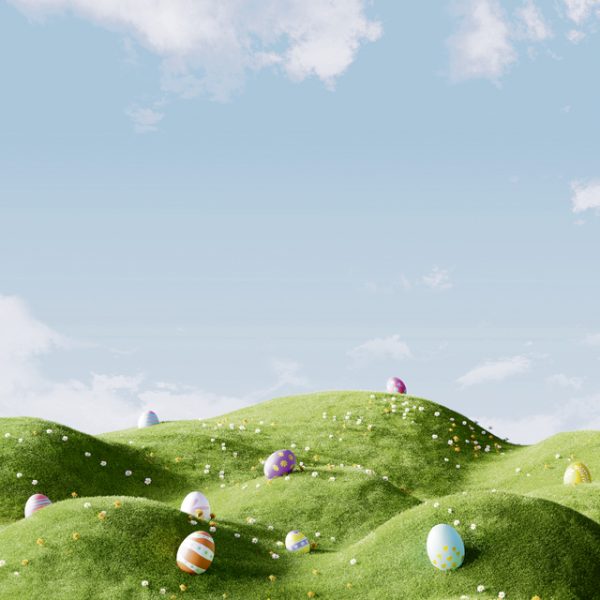
Bunnies, brightly colored eggs, Easter trees, tulips and daffodils, and religious services are all part of Easter traditions in Germany and other European countries. They remind us that spring with all its freshness and color is full in bloom.
Next week, Friday to Monday marks a long Easter weekend in Germany. Both Good Friday (April 18) and Easter Monday (April 21) are public holidays in Germany and all stores, banks and official offices are closed. Switzerland and the Netherlands are closed on Friday, while Luxembourg, France and Belgium treat Easter Monday as a public holiday.
You may have already spotted an Ostereierbaum (Easter tree) in your village square or neighbor’s front yard where bushes and trees are decorated with colorful eggs. Easter markets have also become rather popular offering decorations, special treats of the season and even carousels and activities for children with a springtime twist.
You might soon even experience an Osterfeuer, a large bonfire, usually lit on the night before Easter in parts of Germany and the Netherlands. This old tradition is believed to ward off evil spirits and bring good fortune. In some areas the fires were also used as a type of spring cleaning, where no longer needed furniture, household items or clothes were burned to tidy up the house.
A popular sport during the season is “Ostereierschiessen” (Easter egg shooting). Contestants shoot at paper goals marked with Easter figures or eggs with the aim of hitting as many “eggs” as possible. Each successful shot brings about a real egg and the winner of a whole tournament is crowned as the “Schützenkönig” (archer king).
Another German tradition may not be quite so familiar. Beginning the weekend of celebration on Thursday, referred to as “Gründonnerstag” (green Thursday) foods are held in green. Tradition has it that some families only eat pure vegetarian meals, and popular dishes include spinach with potatoes and fried eggs, potatoes with green herb sauce, a specialty from Frankfurt, or egg salad with mustard and herb dressing.
In honor of St. Peter, who was a fisherman, fish is typically served, fried or steamed, on Friday. Salmon with potatoes and green asparagus is popular, while kids may prefer simple fish sticks. An Easter Sunday dish could be “falscher Hase” (false rabbit), a type of meatloaf, or the traditional Easter lamb, served with rosemary potatoes and fresh spring vegetables. Typical desserts include carrot cake, a braid shaped cake called “Osterzopf” or cakes and cupcakes with fresh fruits and cream. Chocolate Easter bunnies, eggs, chicks and other sweets remain the all-time favorites for younger (and older) children.
Many other European countries have special foods associated with Easter. In Italy, Colomba di Pasqua (Easter dove) is a sweet, dove-shaped bread, while in Greece, Tsoureki, a sweet, braided bread, is a popular treat. In the UK, hot cross buns are traditionally eaten on Good Friday.
Easter traditions around Europe
Processions and parades are also a common means of observing the highest Christian holiday. In Spain and Italy, Holy Week (the week leading up to Easter) is marked by elaborate processions and parades. In Spain, Semana Santa processions involve participants dressed in traditional robes and hoods, carrying religious icons and statues through the streets.
Water splashing is popular in some eastern European countries. In Hungary, Slovakia, and the Czech Republic, Easter Monday is celebrated with a unique tradition called “Sprinkling” or “Whipping Monday.” Boys splash water on girls and lightly tap them with willow branches, a ritual believed to bring health and beauty to the women.
Easter witches are common in Sweden and Finland, where children dress up as witches, resembling Halloween, and go door-to-door, offering drawings and paintings in exchange for sweets.
A somewhat older tradition in Germany, Austria and Switzerland is to pull moss from below trees and shrubs and bind it into natural Easter baskets for the bunny to fill with eggs and small gifts. Self-made willow baskets are also popular, and younger families might plant wheat seeds into a glass bowl or vase about three weeks prior to the holiday for children to watch the Easter nest grow.
Northern Germany has a very special tradition with the Easter bunny hopping around the beaches at the North and Baltic Seas and dropping eggs in the sand. Children will then dig for the precious “seafood” with buckets and shovels.
As in the United States and large parts of Europe, Easter egg hunts are a popular activity in England. Decorated real eggs or chocolate ones are hidden in gardens and parks, while some larger events take place in historic estates and contestants can win prizes for finding the most eggs. Egg rolling is also a popular and fun tradition, played in some areas in England. Hard-boiled eggs are rolled down a hill or across a field and the goal is to see whose egg rolls the farthest without breaking.
In Greece, Easter eggs are typically dyed a deep red color to symbolize the blood of Christ. The eggs are then blessed during church services and used in the traditional game of “tsougrisma,” where participants tap their eggs against each other to see whose egg remains uncracked.
Peter Cottontail and eggs
Rabbits have historically been seen as a symbol of fertility and offspring can be up to 20 bunnies. In addition, in Byzantium a rabbit was an early symbol for Christ. Both in Greek and Germanic mythology, rabbits were considered to be holy animals for Greek Goddess Aphrodite and for Germanic Spring and Fertility Goddess Ostera.
According to legend, children were sent to meadows to search for eggs in Switzerland, and since they more often saw rabbits than hens, they believed that “Peter Cottontail” had left the eggs. In Germany, the rabbit first became popular in 1678 (Reformation time) by Protestant families and the bunny finally became a “star” thanks to the chocolate industry!
The spring season offers a lot of fun and exciting events, see Unterwegs on Page 19 for inspiration!


